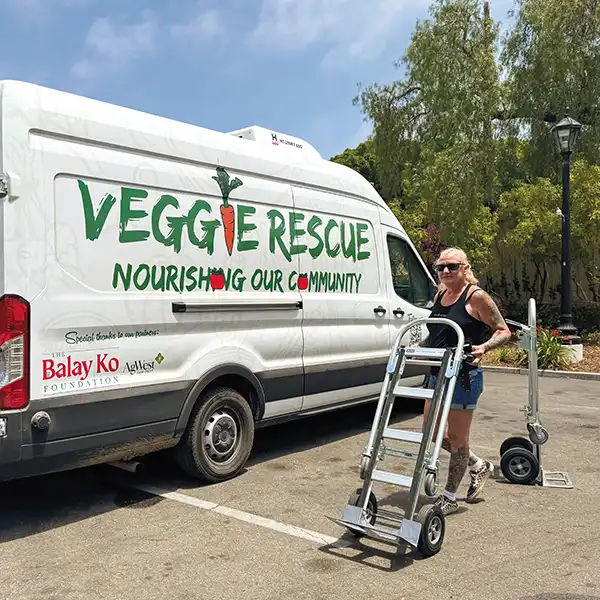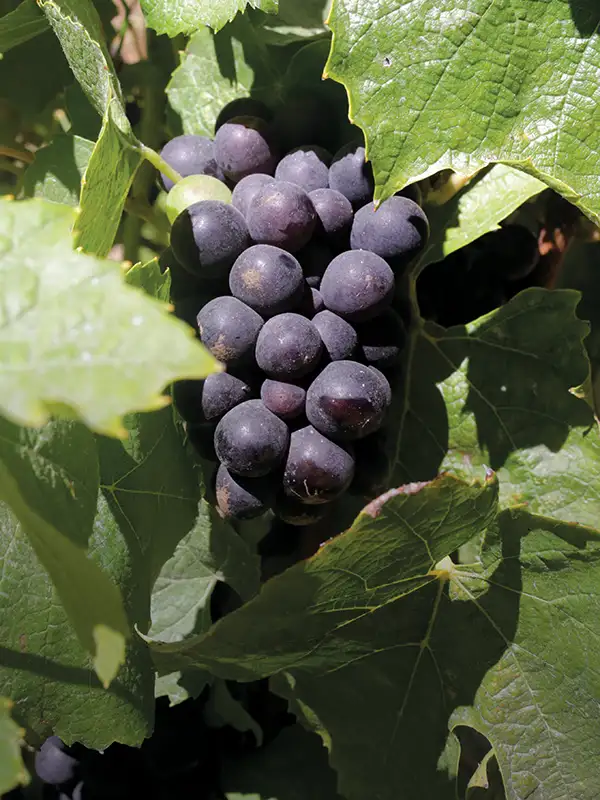Veggie Rescue: Now That We Know: What Are We Going To Do About It?

Imagine this: You’re sitting at a table, an empty dish in front of you. You’re hungry, very hungry. A big bowl of vegetables and fruit sits at the far end of the table just out of reach. Suddenly someone comes along, removes the bowl of food and dumps it into the trash. Like a bad dream, a nightmare really.
The world wastes about 2.5 billion tons of food or about one-third of all food produced every year. The United States alone discards more food than any other country in the world: nearly 133 billion pounds a year. That’s estimated to be almost 40% of the entire U.S. food supply.
While food waste primarily comes from America’s homes and restaurants, about 18% comes from farms. Farming isn’t a perfect science and, depending on the weather, the crop, consumer demand and other variables, farmers too often have leftover produce and sometimes lots of it.
California is now the leading agricultural state in the country, and Santa Barbara County ranks 12th in the state for agricultural production. There are more than 720,000 acres of agricultural land of which about 20% is dedicated to fruits, vegetables and nuts. Santa Barbara County can take pride in the diversity of our crops, our increasing attention to environmental health and the growth in organic farming, but still there are crops farmed that never make it to market and instead end up in landfills or they’re plowed back into the earth. In fact, there is more food waste in U.S. landfills than any other element.
Considering such agricultural abundance and the unfortunate waste of unclaimed crops, it’s sad to say that there are thousands of people in Santa Barbara County who are suffering from food insecurity. In fact, California has the highest child and family poverty rate of any state in the U.S. In fact, Santa Barbara County has the second-highest poverty rate out of all 58 counties in California with nearly 20% of residents living below the poverty line. In fact, approximately 25% in our county live without the food necessary to put a healthy meal together even as agriculture is the number one contributor to our local economy. In fact, more than 61% of our school children meet the requirements for free school meals. That’s a lot of hunger.
What’s wrong with this picture? How can it be that Santa Barbara County is rich in agriculture and yet too many of our vegetables go to waste while too many of our neighbors go hungry?
And now that we know, what are we going to do about it?
Terry Delaney knew what to do about it. A long-time resident of the Santa Ynez Valley, he knew some farmers. He knew they had perfectly good crops sitting in their fields that might never make it to market. He called on a couple of those farmers and asked if he could gather some of their fruits and vegetables and bring them to a local nonprofit organization to feed those who needed fresh foods. And that was when the concept for Veggie Rescue was first envisioned. It was simply a good idea in the year 2006.

Glean was the word Terry used rather than gather. He peppers every sentence with the word glean, meaning to gather slowly and laboriously bit by bit. And that’s exactly what Terry did and is still doing.
“The farmers that I initially turned to agreed to let me go into their fields and glean those vegetables that were sitting there,” Terry explains with a lilt in his voice that he’s probably had since first imagining Veggie Rescue. “They would show me which rows of crops I could glean. They could see that I was very respectful of their land and trusted that I would deliver the produce to a local charity as promised. It was just me at the start, me and my pickup truck.
“If my memory is correct, my first delivery was to Meals on Wheels, who used the produce for meals prepared for the Buellton Senior Center and others.”
Was a time when people went no farther than the neighbors’ farms and local markets in order to put food on their tables. With the development of refrigeration along with the advancement of highly efficient transportation systems—highways, trains, steamships—people could enjoy foods from across the country if not from around the world any time of the year. Industrialization made food production less expensive. Good for the consumer but not so for most of the small family-owned farms who couldn’t compete with the big guys. Without enough takers for crops grown by small-scale farms, waste results.
Today there are about 55 local farms feeding Veggie Rescue so that Veggie Rescue can feed those in need.
Having spent much of his life in and around the food industry, Terry understands the problem. His family owned and operated Newport Beach–based Delaney Bros. Seafood company when Terry was growing up. Terry later worked in marketing for a large food supplier. But Terry is hardly a corporate guy. As the cozy communities of Orange County grew into bustling cities, Terry and his wife, Holly, wanted out. They discovered and fell in love with the Santa Ynez Valley, a place where they could have land and dogs and horses. They made their move to the Valley about 35 years ago and settled in a house on several acres in the midst of farm country.
One of Veggie Rescue’s first farmer partners was Shu and Debbie Takikawa of The Garden of….., well-respected for their 65 acres of organically farmed land, as well as for their generosity in sharing what they grow with those less fortunate.

“We got involved with Veggie Rescue just as soon as Terry told us about it,” Debbie Takikawa tells me as we walked along the farmland that has been in her family since 1952. “We’ve always donated some of what we grow. It’s a state of mind, being able to create enough so that we have enough to give to others.
“Gleaning was once the only way peasants got food. Everything that was worth harvesting went to the upper class. The peasants were then allowed to pick up the leftovers. Gleaning arises out of the most ancient of farming processes and here we are today. Some things just don’t change!” Debbie adds with a knowing nod.
With little, if any, question about the valuable role Veggie Rescue was starting to play in our community, Los Olivos Rotary and then-President Richard Nagler stepped in as early supporters. The Orfalea Foundation eventually provided the funding for Veggie Rescue’s first refrigerated truck. Given the logo, a larger than life carrot painted on the side of the truck, Veggie Rescue now had a certain identity.

“That carrot has become synonymous with nourishing our community,” says Terry. “When you see the big carrot on the Veggie Rescue truck rolling down the road, I think it makes people smile.
“We now have three large refrigerated trucks which we keep parked at my home in Santa Ynez. No warehouse for us. The food goes into our trucks, and the next time it comes out is at the recipient’s location. That’s how we keep our costs down and the food fresh.”
As Terry reached out to neighboring farms, one farmer told the next about Veggie Rescue and before too long Terry was partnered with small- and large-scale farmers throughout Santa Barbara and surrounding counties interested in donating their excess produce while eliminating waste on their properties. Terry let it be known that any farmer who wanted to take part in Veggie Rescue’s mission was welcome. Today there are about 55 local farms feeding Veggie Rescue so that Veggie Rescue can feed those in need. Over time, local donors, food producers and supply companies, including Trader Joe’s in Santa Barbara and Sysco in Ventura, joined the mix, offering food products that were nearing their “use-by” dates but were still perfectly good for eating.
As the roster of participating farms grew, so did the list of recipient partners, a list that’s grown to over 65 local nonprofit distribution sites who largely depend on Veggie Rescue’s deliveries to feed their hungry, including children, working families, seniors and the unhoused. Veggie Rescue proudly counts Good Samaritan Shelters, Bethania Lutheran Church, People Helping People, LEAP (Learn, Engage, Advocate, Partner), Solvang Senior Center, Santa Ynez Valley Community Outreach, Santa Barbara Rescue Mission, Foodbank of Santa Barbara County and many others as worthy partners.
Long before there was any kind of budget for staff, there were good friends who helped put together the many working wheels that make Veggie Rescue run. With Executive Director Eryn Shugart currently at the helm, Veggie Rescue now boasts a staff of four dedicated team players along with the support of passionate board members and volunteers.
Terry tells me that Veggie Rescue is on the road seven days a week, picking up from their farmer partners and delivering what was gleaned to recipient partners the very same day. Veggie Rescue is currently delivering about 630,000 pounds of food a year with an estimated value of well over a million dollars.

Veggie Rescue isn’t only feeding the hungry but feeding imaginations and inspiring others, as well. Good Samaritan Shelter, a nonprofit agency that provides support services to the unhoused and those in recovery throughout Santa Barbara County, was one of Veggie Rescue’s first recipients of fresh produce. In early 2023, Good Samaritan hired organic farmer Jeff Hendrickson to start its own organic farm on four acres of land in Lompoc.
BridgeHouse Farm, as the venture is named, now provides fresh fruit and produce to Good Samaritan’s shelter system while also providing agriculture vocational training for their clients in the system. And because BridgeHouse is growing more produce than they can use, they’re able to give back to Veggie Rescue which drops off produce for Good Samaritan and, at the same time, picks up BridgeHouse’s surplus. Good for everyone involved.
“Many hands make work light” is one of Terry’s favorite lines. It’s clearly taken the farmers, the recipients and the many helping hands, including the financial support from grants, local foundations and individual donors, to form the successful operation that allowed Veggie Rescue to grow to where it is today. As “Santa Ynez Valley Fruit and Vegetable Rescue,” Veggie Rescue qualified as a 501(c)(3) nonprofit organization in 2010 and just celebrated their 15th anniversary.
It’s not so easy writing a compelling story that has little conflict. Veggie Rescue has had little, if any, conflict. Only promise. Until now.
Veggie Rescue’s farming partners and distribution centers are up against what could be crippling federal funding cuts from programs that address child care, senior care, housing assistance and farming assistance. As Eryn put it, we’re facing a potential crisis in food acquisitions and distribution.
Independent farmers, ranchers and fisherfolk are currently threatened as the federal government is dismantling agencies and defunding programs such as USDA’s Farm Service Agency and the Natural Resources Conservation Services, meaning that essential services that support our independent farmers will no longer be readily available. Services such as financial assistance. Services such as agriculture research and conservation assistance. Services that allow a farmer to create a business plan and to be able to count on the funding needed to proceed with that plan.
And what about supply chains? The USDA once purchased goods from our farmers and then distributed the items to those with food insecurity. No longer. That program was cut along with about $1 billion in federal aid to anti-hunger groups. USDA programs that support the creation and nurturing of crucial local markets, including schools, food banks and distribution hubs have been canceled, shutting down valuable markets for farm products. Those programs accounted for more than a billion dollars’ worth of contracts for farmers.

It’s the small, family-owned and operated farms that suffer. Will they be able to survive without government assistance, without buyers for their produce?
It’s those with food insecurity that suffer. What do we expect them to eat and where will that food come from?
I ask again: Now that we know the problem, what are we going to do about it?
Fortunately, Veggie Rescue isn’t dependent on federal funding. Instead, the organization partners with local farms and businesses, rescuing foods that might otherwise go to waste and then delivering those edibles to food pantries, shelters and senior centers throughout the county.
If I’m repeating myself, some things are worth repeating. Veggie Rescue’s model is simple and effective. It makes such good sense. Why didn’t I think of it?!

A van full of tomatoes from Tutti Frutti Farms. Courtesy: Veggie Rescue 
Olga Leatherbury on a mission for Veggie Rescue. Photo: Rosminah Brown
“Current budget cuts have created more need, more food insecurity,” explains Eryn. “It doesn’t make our job any easier. But we’re committed to meeting our mission and increasing our impact in terms of food donations for those who are most vulnerable.”
Eryn stresses the need for community support to fill in where the government left off. Literally left off. Local support is critical to the health of Veggie Rescue more than ever right now.
“You have to have courage and vision to move forward,” Terry Delaney adds with a deep sigh. “You have to be willing to open doors that have perhaps never been opened before. That’s how Veggie Rescue came to be.”
One can’t help but applaud Terry for his commitment to community service even as he assures me that he’s simply a volunteer. In fact, he is. He’s also a visionary and a humanitarian, just two of the terms frequently applied to Terry. He has stepped back from the daily business of Veggie Rescue but, as Honorary Chair of the Board, Terry is still the engine, the heart and the soul behind the organization.
I personally saw the Veggie Rescue truck with the oversized carrot driving through downtown Solvang the other day. And, yes, it made me smile. An hour or so later I saw the truck again at Trader Joe’s on De La Vina Street in Santa Barbara. I walked over to the truck and introduced myself to the driver, Olga Leatherbury. I told her I was doing a story on Veggie Rescue. She smiled politely and then turned around to continue packing the truck with boxes of food. She was on a mission.






